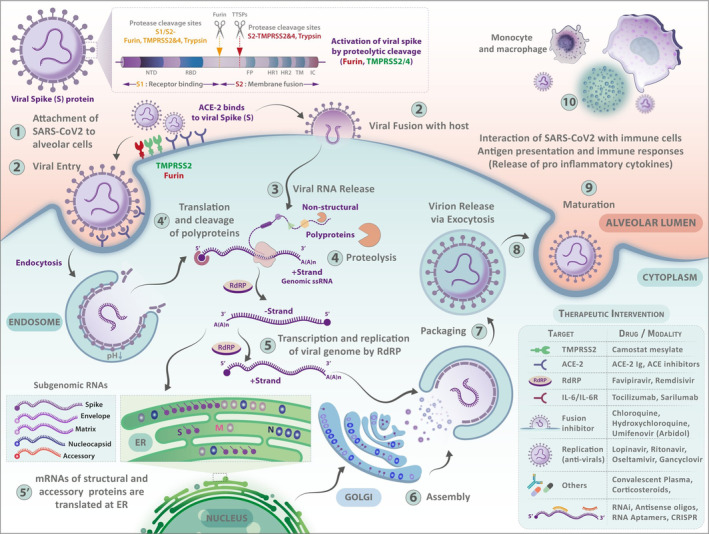FIGURE 1.

The life cycle of severe acute respiratory syndrome coronavirus 2 (SARS‐CoV‐2). (1) The cycle begins with the virus entering cells of the airway. Viral attachment is mediated by the interaction between the viral spike (S) protein and host ACE2 receptors with the serine protease TMPRSS2 co‐receptors. Furin cleaves the spike protein to make it functional for priming and activation. (2) Either by endocytosis or membrane fusion, the virus enters the host cell. (3) This event is followed by the release of viral ssRNA into the host cell. The release of the viral genome triggers the signals for activation of intracellular pattern recognition receptors such as TLR7 that usually lead to the synthesis of antiviral interferons. (4 & 4′) Subsequently, the translation and cleavage of the viral polymerase protein occur in the cytoplasm. (5 & 5′) RNA replication depends on the viral RNA‐dependent RNA polymerase (RdRp). Translation of viral structural proteins occurs via the ribosomes in the endoplasmic reticulum (ER). (6) Virion assembly occurs at ER‐Golgi junctions in concurrence with (7) the formation of mature virions inside Golgi vesicles. (8) Post‐assembly, the infective virions are released via exocytosis or through cell lysis. The inset table shows possible intervention points for SARS‐CoV‐2 at multiple stages of its life cycle. These repurposed drugs intercept the SARS‐CoV‐2 infection at crucial points, including inhibiting the viral proteins or interfering with viral entry, translation of viral proteins, assembly of new virions, viral budding, etc. Many repurposed/experimental drugs also possess off‐target side‐effects contributing to drug‐induced cytotoxicity, local tissue damage, and systemic immunosuppression
